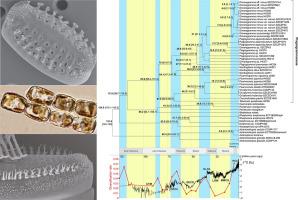当前位置:
X-MOL 学术
›
Mol. Phylogenet. Evol.
›
论文详情
Our official English website, www.x-mol.net, welcomes your
feedback! (Note: you will need to create a separate account there.)
Morphology, phylogeny, and molecular dating in Plagiogrammaceae family focused on Plagiogramma-Dimeregramma complex (Urneidophycidae, Bacillariophyceae).
Molecular Phylogenetics and Evolution ( IF 3.6 ) Pub Date : 2020-03-31 , DOI: 10.1016/j.ympev.2020.106808 Chunlian Li 1 , Matt P Ashworth 2 , Paweł Mackiewicz 3 , Przemysław Dąbek 4 , Jakub Witkowski 4 , Ewa Górecka 4 , Marta Krzywda 4 , Andrzej Witkowski 4
Molecular Phylogenetics and Evolution ( IF 3.6 ) Pub Date : 2020-03-31 , DOI: 10.1016/j.ympev.2020.106808 Chunlian Li 1 , Matt P Ashworth 2 , Paweł Mackiewicz 3 , Przemysław Dąbek 4 , Jakub Witkowski 4 , Ewa Górecka 4 , Marta Krzywda 4 , Andrzej Witkowski 4
Affiliation

|
Although previous phylogenetic analyses suggested that the araphid diatom family Plagiogrammaceae is monophyletic, there is still not a clear understanding of relationships among the genera, and the taxonomy of several genera--Dimeregramma and Plagiogramma--remains questionable in light of paraphyly for both genera using molecular and morphological data. We have expanded the available DNA for molecular work for dozens of plagiogrammacean clones and analyzed 29 morphological characters from plagiogrammarian taxa and closely related genera, to increase understanding of the evolutionary history and systematics of the family and re-evaluate the current taxonomical classification of plagiogrammacean genera. The addition of more taxa and more data confirm the results from previous molecular phylogenies: most plagiogrammacean genera are monophyletic, except for Dimeregramma and Plagiogramma. Interestingly, the morphological analysis resolves only Talaroneis and Glyphodesmis as monophyletic. Given these results, we feel there is limited support for retaining Dimeregramma and Plagiogramma as distinct genera, and formally propose amending Plagiogramma and transferring six Dimeregramma species. As the Plagiogrammaceae is also one of the first-diverging clades of pennate diatoms, we also used these molecular data to estimate the age of the family, based on multiple calibration points derived from fossil taxa within or close to the Plagiogrammaceae. The results indicated that the Plagiogrammaceae evolved more than 114 million year ago and its diversification appears to correspond to a time of climate cooling. Additionally, we described a new monotypic genus (Coccinelloidea) with one new species C. gracilis, and five new species within established genera, e.g. Plagiogramma marginalis, Plagiogramma harenae, Plagiogramma porcipellis, Neofragilaria montgomeryii and Psammogramma anacarae.
中文翻译:

斜纹夜蛾科的形态,系统发育和分子定年集中在斜纹夜蛾-双歧夜蛾复合体(Urneidophycidae,Bacillariophyceae)。
尽管先前的系统发育分析表明,阿拉伯蚜虫硅藻科(Plagiogrammaceae)是单系的,但对属间的关系仍然缺乏明确的了解,鉴于属相,两个属(Dimeregramma和Plagiogramma)的分类学仍存在疑问分子和形态数据。我们已经扩展了数十种虫科动物克隆的分子生物学可用DNA,并分析了虫科和近缘属的29个形态特征,以加深对家族进化史和系统学的了解,并重新评估valu虫科的当前分类学分类。增加了更多的分类单元和更多的数据证实了先前分子系统发育的结果:大多数most谱属是单系的,除了Dimeregramma和Plagiogramma。有趣的是,形态分析仅将塔拉罗尼斯和草甘膦分解为单系的。鉴于这些结果,我们认为保留Dimeregramma和Plagiogramma作为不同属的支持有限,并正式建议修改Plagiogramma和转让6种Dimeregramma。由于斜纹夜蛾科也是最早的戊二烯硅藻进化枝之一,因此,我们还根据来源于斜纹夜蛾科内或附近的化石类群的多个校准点,使用了这些分子数据来估计该科的年龄。结果表明,斜纹夜蛾科进化超过1.14亿年前,其多样化似乎与气候变冷的时期相对应。此外,我们描述了一个带有一个新物种C的新单型属(Coccinelloidea)。
更新日期:2020-03-31
中文翻译:

斜纹夜蛾科的形态,系统发育和分子定年集中在斜纹夜蛾-双歧夜蛾复合体(Urneidophycidae,Bacillariophyceae)。
尽管先前的系统发育分析表明,阿拉伯蚜虫硅藻科(Plagiogrammaceae)是单系的,但对属间的关系仍然缺乏明确的了解,鉴于属相,两个属(Dimeregramma和Plagiogramma)的分类学仍存在疑问分子和形态数据。我们已经扩展了数十种虫科动物克隆的分子生物学可用DNA,并分析了虫科和近缘属的29个形态特征,以加深对家族进化史和系统学的了解,并重新评估valu虫科的当前分类学分类。增加了更多的分类单元和更多的数据证实了先前分子系统发育的结果:大多数most谱属是单系的,除了Dimeregramma和Plagiogramma。有趣的是,形态分析仅将塔拉罗尼斯和草甘膦分解为单系的。鉴于这些结果,我们认为保留Dimeregramma和Plagiogramma作为不同属的支持有限,并正式建议修改Plagiogramma和转让6种Dimeregramma。由于斜纹夜蛾科也是最早的戊二烯硅藻进化枝之一,因此,我们还根据来源于斜纹夜蛾科内或附近的化石类群的多个校准点,使用了这些分子数据来估计该科的年龄。结果表明,斜纹夜蛾科进化超过1.14亿年前,其多样化似乎与气候变冷的时期相对应。此外,我们描述了一个带有一个新物种C的新单型属(Coccinelloidea)。











































 京公网安备 11010802027423号
京公网安备 11010802027423号